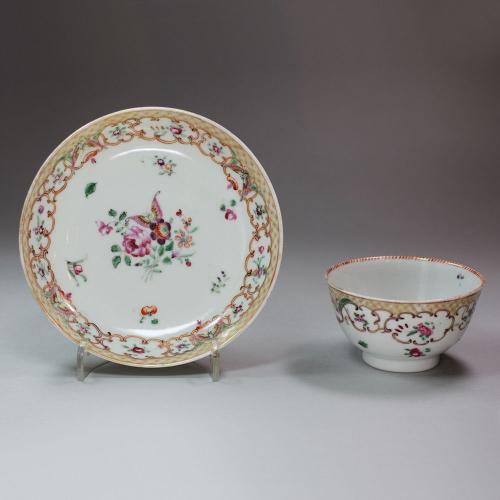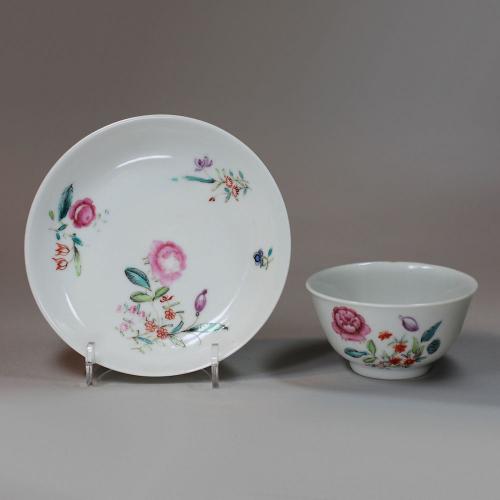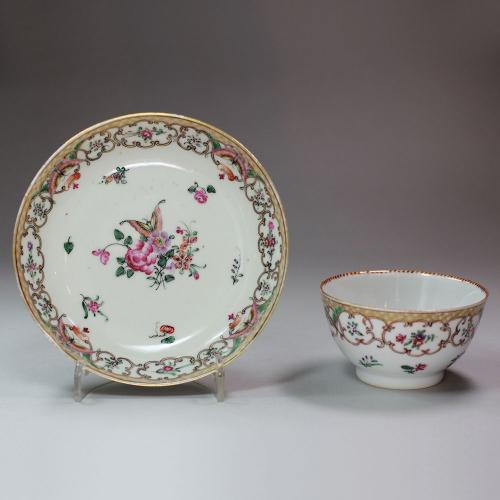
Price on application
This object is eligible for a Certificate of BADA Provenance
The BADA Standard
- Since 1918, BADA has been the leading association for the antiques and fine art trade
- Members are elected for their knowledge, integrity and quality of stock
- Our clients are protected by BADA’s code of conduct
- Our dealers’ membership is reviewed and renewed annually
- Bada.org is a non-profit site: clients deal directly with members and they pay no hidden fees
Chinese Transitional Gu-form beaker vase, Chongzhen (1627-1644), with spreading base and flaring trumpet rim, superbly painted in shades of high 'transitional' vibrant underglaze cobalt blue, the upper section with a riverside scene containing a warrior with a long polearm and wearing a flowing tunic in conversation with a lone barefooted fisherman, while a lady stands beside their two horses, amongst boulders and bamboo, with rocky cliffs and a tall wall visible through the swirling clouds, above a wide band of ruyi heads amongst stylised scrolling foliage, all between bands of anhua decoration (hidden or secret) and the lower section with a further band of stiff leaves.
Dimensions:
Height: 45.5cm. (17 7/8in.)
Condition:
Rim chips; the larger one with an associated short hair-line
Notes:
Vases of this period and quality have become extremely rare to the point that it would be extremely difficult to find a similar vase for sale elsewhere.
A similar pair of Transitional gu-shaped vases from the Michael Butler Collection are illustrated in Canepa, Teresa and Butler, Katherine, 2021, Leaping the Dragon Gate: The Sir Michael Butler Collection of 17th-Century Chinese Porcelain, Ad Ilissvm, London (fig.III.2.85; pp.219-221). These vases have the same overall decoration but a different narrative scene depicted on the top section.
Another similar gu-shaped vase but with a different scene depicted on the upper section can be found in the collection of the Museum of Asian Art, Bath (BATEA : 380). This example has the same bands of foliate scroll and stiff leaves, and bears an inscription which dates the vase to 1639.
A relalted vase, but of poorer quality can be found in the collection of the British Museum (Franks.113) and was donated by Sir Augustus Wollaston Franks.
It is likely that the scene depicted on this vase is taken from the Chinese historical novel Romance of the Three Kingdoms (三國演義), as Lu Bu, a semi-historical main character in the tale, can be identified by the polearm which he carries. The character came to be associated with a variation of the ji, a Song dynasty infantry weapon, known as the fangtian huaji, which had a spear tip and crescent blade on one side. Lu Bu is described in the text as having ‘a lofty and dignified look, a majestic and awe-inspiring bearing, wielding a fangtian huaji […] hair pulled back and worn in a golden headdress, donning a flowery-patterned battle robe’. The woman accompanying him is possibly Diaochan, a fictional character from the history who is described as a beautiful and talented maiden with extraordinary charm and grace. Her character plays a crucial role in the political intrigue and betrayal central to the novel, and it is likely that the scene depicted here is after she incites Lu Bu to betray Dong Zhuo and he flees Chang’an to seek political refuge. Throughout the novel, which deals with battles, intrigues and struggles of states during the turbulent hundred year period from the end of the Han dynasty (189-220AD) to the end of the Three Kingdoms period (220-280 AD), there are multiple instances where characters including Lu Bu rely on rivers either to escape or pursue a foe. Though known for his martial prowess, Lu Bu loses favour with various warlords and finds himself without a secure power base; his volatile allegiances lead to more betrayals, shifting alliances and his ultimate capture and death.
Porcelain made in the interim period after the decline of the Ming but before Qing dominance frequently features scenes from Romance of the Three Kingdoms and other classic texts. During this period of upheaval in China, lack of imperial patronage meant that the highly skilled potters of Jingdezhen were forced to innovate and look for new markets in order to survive, resulting in a new range of highly dynamic and varied designs. Developments in print technology and the consequent expansion of printed material meant that histories and romances were incredibly popular at this time and also provided artists with a wide range of visual sources from which to draw inspiration. The Romance of the Three Kingdoms, written in the 14th century by Luo Guanzhong, was particularly popular, with scenes and characters from the novel becoming iconic and well known symbols of Chinese history and culture. Potters catered to this demand, with wares showcasing skilfully painted scenes from the epic tale. The popularity of the Romance continued into the Qing; testament to the enduring impact of the novel and the artistic impressions which emerged during the Transitional period, though the exquisite palette of blues known as ‘violets in milk’ gave way to famille verte and famille rose designs as enamel technology advanced.
Provenance:
From Carrycoats Hall, Northumberland.
Carrycoats Hall, a Grade II listed house erected in the 1830s, incorporates remnants of earlier buildings from the 17th and 18th centuries; the oldest parts of some walls could be remnants of a bastle (fortified farmhouse) documented in 1541. The walled gardens date to the 18th century and have their own listing. The township of Carrycoats, in the parish of Thockrington, Northumberland lies just outside the town of Hexham and today has a population of around 50 inhabitants. The lands were probably the appanage (provision made for a younger child of a monarch or ruler) of a younger branch of the Shafto family which had been established in Northumberland since at least the 14th century: the family were still in residence at Carrycoats in the late 20th century.
Dimensions
Height: 45.5cm. (17 7/8in.)Condition report
Rim chips; the larger one with an associated short hair-lineStock number
W775The BADA Standard
- Since 1918, BADA has been the leading association for the antiques and fine art trade
- Members are elected for their knowledge, integrity and quality of stock
- Our clients are protected by BADA’s code of conduct
- Our dealers’ membership is reviewed and renewed annually
- Bada.org is a non-profit site: clients deal directly with members and they pay no hidden fees




